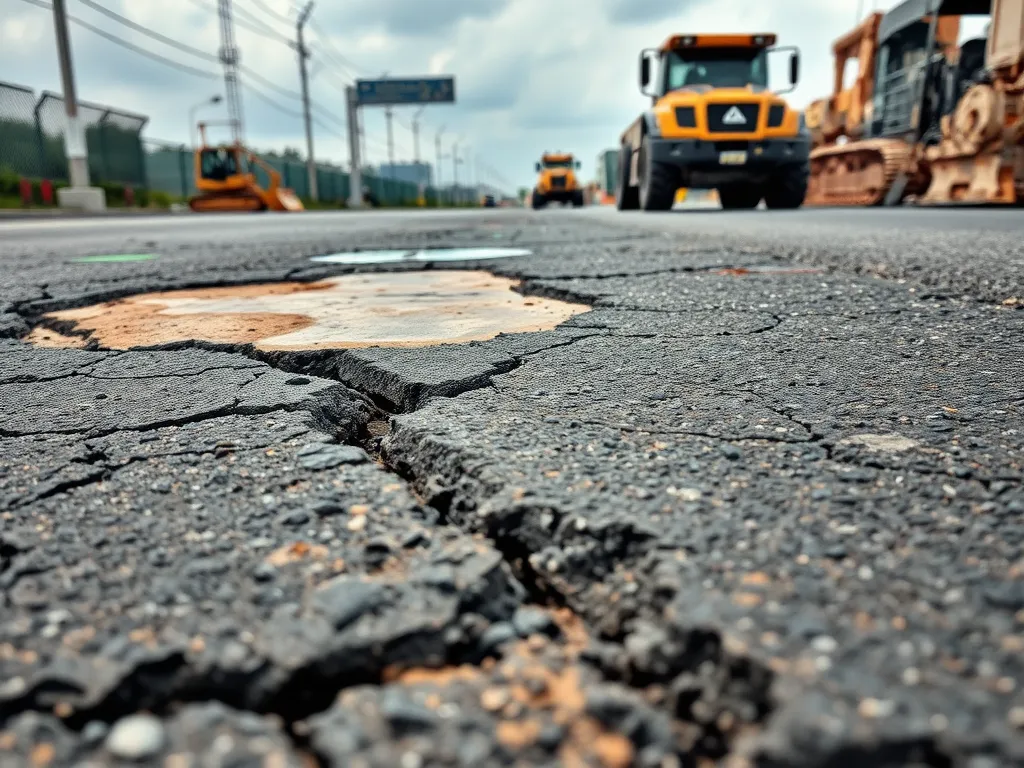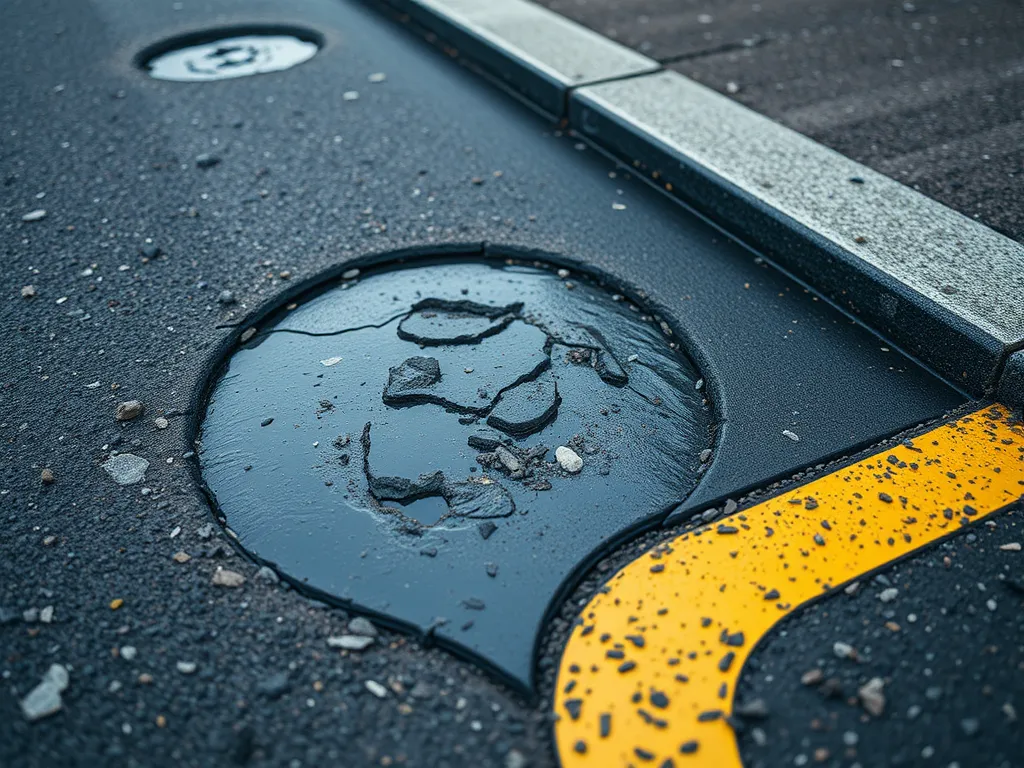Challenges in Repairing Asphalt Roads
Published on: October 10, 2025 | Last Updated: April 14, 2025
Written By: George Voss
Repairing asphalt roads presents complex challenges from aging infrastructure to environmental impacts. Common issues include cracks from freeze-thaw cycles (water expands when frozen, breaking pavement), ruts from heavy trucks, and potholes caused by water infiltration. Modern repairs use techniques like infrared thermal patching (heating existing asphalt for seamless repairs) and full-depth reconstruction (replacing entire pavement layers). Costs range from $2-$5 per square foot for minor fixes to $8-$15 for major overhauls. Eco-friendly methods now incorporate recycled asphalt pavement (RAP), cutting material waste by 30% compared to traditional methods.
This article breaks down the hurdles faced in maintaining asphalt roads. We’ll explore why pavements fail, how traffic and weather accelerate damage, and why timing repairs matters. You’ll see cost comparisons for crack sealing versus full reconstruction and learn how new technologies tackle temperature sensitivity during installation. We’ll also cover sustainability efforts like RAP usage and energy-efficient machinery reducing carbon footprints in roadwork projects.
Contents
- Introduction to Asphalt Road Repair Challenges
- Common Causes Of Asphalt Pavement Failure
- Life Expectancy Of Asphalt Roads
- Is Asphalt Easy to Repair?
- Key Challenges in Repairing Asphalt Roads
- Cost Considerations for Asphalt Road Repairs
- Environmental Challenges in Asphalt Road Repair
- Frequently Asked Questions (FAQs)
- Closing Thoughts
- Additional Resources for You:
Introduction to Asphalt Road Repair Challenges
Repairs for asphalt roads face multiple obstacles that test even experienced contractors. Weather extremes, heavy traffic loads, and material limitations create a complex puzzle for maintenance crews. Common asphalt road repair difficulties range from surface cracks expanding into structural damage to drainage issues accelerating wear.
Temperature fluctuations rank among the top asphalt pavement repair challenges. Asphalt contracts in cold weather and expands under heat, creating stress fractures. Add daily vehicle loads exceeding 40,000 pounds per axle, and minor defects quickly escalate. Proper repairs demand precise timing – too hot, and fresh mix won’t compact; too cold, and bonding fails.
Material quality directly impacts asphalt road maintenance challenges. Substandard aggregates or poorly graded asphalt mix (like incorrect PG 64-22 binder use) lead to premature raveling. Workmanship errors during installation account for 23% of early pavement failures according to NAPA studies.
These foundational hurdles set the stage for examining the specific factors that lead to pavement breakdowns.
Common Causes Of Asphalt Pavement Failure
Asphalt road repair challenges often stem from preventable failures. Identifying root causes helps prioritize fixes and avoid recurring issues.
Most Common Cause Of Pavement Failure
Water infiltration triggers 85% of asphalt pavement failures. When cracks form, moisture penetrates the base layer, weakening structural integrity. Freeze-thaw cycles expand this damage, creating potholes and alligator cracking. Repair teams must address drainage issues first to prevent repeat failures.
Primary Factors Damaging Asphalt Roads
Three forces dominate asphalt road repair difficulties:
| Factor | Impact | Repair Complexity |
|---|---|---|
| Heavy truck traffic | 15,000+ lb axle loads deform surfaces | Requires full-depth patching |
| UV oxidation | Brittleness increases 40% over 7 years | Needs surface rejuvenation |
| Chemical exposure | Oil/gasoline dissolve binders | Demands chemical-resistant mixes |
Material Defects and Improper Installation
Substandard materials account for 30% of premature repairs. Low-quality aggregates or incorrect PG (Performance-Graded) binders create weak spots. Installation errors like inadequate compaction below 92% density leave pavements vulnerable to rutting. These hidden defects surface later as asphalt road maintenance challenges requiring costly corrective measures.
With failure causes identified, examining how maintenance extends pavement life becomes critical.

Life Expectancy Of Asphalt Roads
Typical asphalt roads last 15-20 years with original structural capacity. This span shifts based on local climate, traffic load, and material quality. Roads in cold zones with frequent freeze-thaw cycles might show cracks in 8-10 years. High-traffic corridors carrying trucks above 40,000 lbs daily often require resurfacing 30% sooner than low-volume roads. PG (Performance Grade) binders—asphalt’s sticky component—directly impact durability. Modern Superpave mixes, designed for specific thermal conditions, boost longevity by 15-25% compared to conventional asphalt.
Impact Of Maintenance on Asphalt Longevity
Routine upkeep adds 5-8 years to a road’s functional life. Crack sealing within 24 months of paving blocks moisture intrusion, a primary trigger for base layer failures. Seal coating every 3-5 years cuts oxidation rates by 60%, delaying surface raveling. Cities using infrared patching for minor voids report 50% fewer potholes annually. Ignoring small fixes raises full-depth repair costs by $8-$12 per square foot within 5 years. Polymer-modified binders in maintenance mixes resist rutting 40% longer than standard materials.
Poor upkeep forces roads into costly reconstruction 3-4 times faster. A single 1/4-inch crack left unsealed can expand to 2 inches wide in two winters, allowing subgrade saturation. Drainage systems clogged with debris lift flood risks by 70%, accelerating pavement breakdown. Agencies allocating 18-22% of budgets to preventive maintenance slash long-term rebuild costs by 40%.
Upcoming parts discuss how aging pavements complicate asphalt road repair difficulties—particularly when structural harm surpasses surface flaws.
Also See: Adjusting Paver Machine Settings for Different Asphalt Mixes
Is Asphalt Easy to Repair?
Asphalt repairs range from simple fixes to complex overhauls. Success depends on damage severity, material quality, and environmental conditions. While small issues can be addressed quickly, larger repairs face asphalt pavement repair challenges like weather delays and material compatibility.
Techniques for Minor Asphalt Repairs
Minor repairs target surface-level damage under 25% of pavement depth. Common methods include:
- Crack sealing: Fills gaps up to 1″ wide with rubberized asphalt emulsion ($0.50-$2 per linear foot)
- Pothole patching: Uses cold-mix asphalt for temporary fixes or infrared patching for seamless repairs
- Surface treatments: Sealcoating ($0.15-$0.25 per sq.ft) adds a protective layer against UV rays and water
These solutions work best when temperatures stay above 50°F. Winter repairs often fail due to thermal contraction.
Methods for Major Asphalt Repairs
Extensive damage requires structural interventions. Contractors typically use:
- Milling and overlay: Removes 1-3″ of worn asphalt ($2-$5 per sq.ft) before adding new layers
- Full-depth reclamation: Recycles 6-12″ of base materials using stabilizing agents like cement
- Hot-in-place recycling: Repaves roads at 300°F+ temperatures, blending 30% RAP (recycled asphalt pavement)
Heavy equipment like cold planers and vibratory rollers must coordinate with traffic control plans – a key factor in asphalt road maintenance challenges.
While these methods address surface issues, they often mask deeper asphalt repair problems like subgrade erosion or drainage failures. Up next: how aging infrastructure and extreme weather amplify repair complexities.

Key Challenges in Repairing Asphalt Roads
Repair crews face multiple hurdles when fixing asphalt roads. From aging surfaces to harsh weather, these issues demand precise solutions to ensure lasting results.
Aging Infrastructure and Degraded Pavements
Over 45% of U.S. roads show significant wear due to aging. Degraded pavements often hide base layer failures, requiring crews to excavate deeper than surface cracks. Raveling (loose aggregates) and alligator cracking (interconnected cracks resembling reptile skin) signal structural weakness. Full-depth repairs cost $8-$15 per square foot—triple the price of patching.
High Traffic Volume and Heavy Vehicle Loads
Repairs on busy roads face constant pressure from 18-wheelers and commuters. A single truck axle applies 8,000-10,000 pounds of force, accelerating rutting (channel-shaped depressions) and shoving (rippled surfaces). Lane closures or night work add 12-20% to project costs. Hot-mix asphalt needs 6 hours to cool—a tight window under traffic.
Weather-related Repair Complications
Temperature swings and moisture disrupt repair quality. Crews must monitor forecasts to avoid wasted materials.
Freeze-Thaw Cycle Damage
Water seeps into cracks, expands by 9% when frozen, and fractures pavement. Ten freeze-thaw cycles can widen cracks by 30%. Cold-patch asphalt offers temporary fixes but lasts just 1-3 years versus 8-12 years for hot-mix.
Rain and Moisture Penetration
Wet conditions weaken the aggregate base, causing potholes. Tack coats (adhesive layers between old and new asphalt) fail at 85% humidity, leading to delamination. Proper drainage systems cut repair frequency by 40%.
Seasonal and Timing Constraints
Asphalt mixes require temperatures above 50°F for compaction. Northern states have 5-7 month repair windows, forcing delayed fixes. Spring thaw restrictions limit truck weights, slowing material delivery.
Substandard Materials and Poor Workmanship
Low-grade PG (Performance Graded) binders or incorrect aggregate mixes cause premature failures. Poor compaction—below 92% density—leaves air pockets that invite water damage. Reworking flawed repairs adds $4-$7 per square foot.
Addressing these asphalt road repair difficulties requires planning and precision. Next, let’s examine how costs stack up for different repair strategies.
Cost Considerations for Asphalt Road Repairs
Budget limitations directly influence repair quality. Unpredictable price fluctuations in materials, labor, or equipment complicate planning. Balancing immediate needs with long-term durability requires precise cost evaluation.
Pricing Factors for Minor Asphalt Repairs
Minor fixes like crack sealing or pothole filling range from $1.50 to $3.00 per square foot. Costs depend on crack width, depth, or pothole size. Labor rates vary by region—urban zones often charge $45-$75 hourly. Cold mix asphalt ($20-$40 per bag) suits temporary fixes, while polymer-modified emulsion sealants ($0.15-$0.35 per linear foot) offer longer-lasting results. Equipment like infrared heaters ($200-$400 daily) boosts efficiency but adds upfront expenses.
Cost Breakdown for Major Asphalt Repairs
Resurfacing with hot mix asphalt (HMA) costs $3-$7 per square foot. Full-depth reconstruction jumps to $8-$15 due to milling ($1-$3 per square foot) and base layer repairs. PG (Performance-Graded) binders, designed for specific climates, add $10-$30 per ton. Traffic control measures consume 12%-18% of budgets in high-volume zones. Delays from wet conditions or temperature drops inflate project costs by up to 20%.
| Repair Type | Cost Range | Key Variables |
|---|---|---|
| Crack Sealing | $0.10-$0.35/linear ft | Width, sealant type |
| Pothole Patching | $25-$50 per hole | Depth, material choice |
| Overlay | $3-$7/sq ft | Thickness, HMA grade |
| Reconstruction | $8-$15/sq ft | Base repair, drainage |
Beyond dollars, repair strategies must weigh environmental impacts linked to material sourcing or emissions. Next, we’ll explore how sustainability factors into fixing paved surfaces.

Environmental Challenges in Asphalt Road Repair
Road maintenance teams face mounting pressure to balance durable repairs with ecological responsibility. Two key hurdles stand out: managing recycled materials and cutting energy demands during restoration work.
Recycling Challenges and Material Waste
While 95% of asphalt can be reused, practical barriers limit recycling success. Reclaimed Asphalt Pavement (RAP) – milled material from old roads – often contains contaminants like dirt or unapproved polymers. Blending RAP with fresh PG binders (performance-graded asphalt cement) requires precise temperature control to prevent brittleness. Without proper Superpave mix designs, recycled asphalt may crack within 12-18 months.
- Only 80 million tons of RAP get reused annually, despite 420 million tons available
- Processing RAP adds $8-$15 per ton versus $65-$100 for virgin asphalt
- Limited recycling plants force hauling debris 50+ miles, increasing emissions
Energy Consumption During Repair Processes
Traditional asphalt production burns fossil fuels to heat mixes to 300-350°F, emitting 35-40 kg CO2 per ton. Repairs compound this through:
- Reheating recycled material (2-3 energy cycles per RAP batch)
- Running heavy machinery like hot boxes and pavers for 10+ hours daily
- Night work under artificial lighting for high-traffic zones
Switching to warm-mix asphalt slashes temps to 250-275°F, reducing energy use by 30%. Solar-powered plants now cut grid reliance by 18%, though upfront costs remain steep at $2M-$5M per facility.
Balancing eco-friendly methods with lasting results remains a tightrope walk for road crews. Up next: how these environmental factors influence project budgets and long-term spending.
Frequently Asked Questions (FAQs)
What Are the Key Factors That Contribute to the Challenges Of Asphalt Road Repairs?
The main factors include aging infrastructure, high traffic volumes from heavy vehicles, weather-related issues such as freeze-thaw cycles and moisture infiltration, timing constraints for repairs, and the use of substandard materials and poor workmanship.
How Does High Traffic Volume Impact Asphalt Road Repair?
High traffic volume, particularly from heavy trucks, exerts significant stress on asphalt surfaces, leading to accelerated wear such as rutting and shoving. This necessitates more frequent and extensive repairs, often at higher costs due to additional lane closures and nighttime work requirements.
What Environmental Challenges Are Associated With Asphalt Road Repairs?
Environmental challenges include difficulties with recycling materials like Reclaimed Asphalt Pavement (RAP), as well as high energy consumption during production and repair processes. Balancing durable repairs with ecological responsibility remains a significant hurdle for maintenance teams.
How Can Weather Conditions Affect the Quality Of Asphalt Repairs?
Weather conditions can halt asphalt repair projects, especially if the temperatures drop below optimal compaction levels or if there is significant moisture present. Cold temperatures can prevent proper bonding, while rain can weaken the base and lead to additional structural issues.
What Role Does Proper Timing Play in Asphalt Road Repairs?
Proper timing is crucial, as asphalt mixes need specific temperature conditions for effective compaction and bonding. Delays in repairs can compound existing damages, making future repairs more complex and costly.
Closing Thoughts
Repairing asphalt roads comes with significant challenges. Aging infrastructure, high traffic volumes, and weather-related complications significantly affect repair efforts. Seasonal constraints can further complicate the timeline, while substandard materials may lead to inferior results. Each factor requires careful consideration and strategic planning to ensure successful repairs.
Despite these challenges, effective repair techniques and proper maintenance can extend the life of asphalt roads. Utilizing high-quality materials and adhering to best practices helps combat common issues and enhances durability.
For comprehensive information and tools related to asphalt, visit Asphalt Calculator USA. Stay informed to tackle these challenges effectively.
Additional Resources for You:
- Transportation Research Board (TRB, Peer-Reviewed Research & Circulars)
- 5 Common Types of Asphalt Damage and How to Repair Them
- Asphalt Patching Techniques for Roads, Pavements and Parking Lots – American Asphalt | Bay Area Paving, Repair, Resurfacing 800-541-5559
- Challenges and solutions for crack sealing in asphalt pavements | Roads and Bridges
- Challenges of asphalt repair


